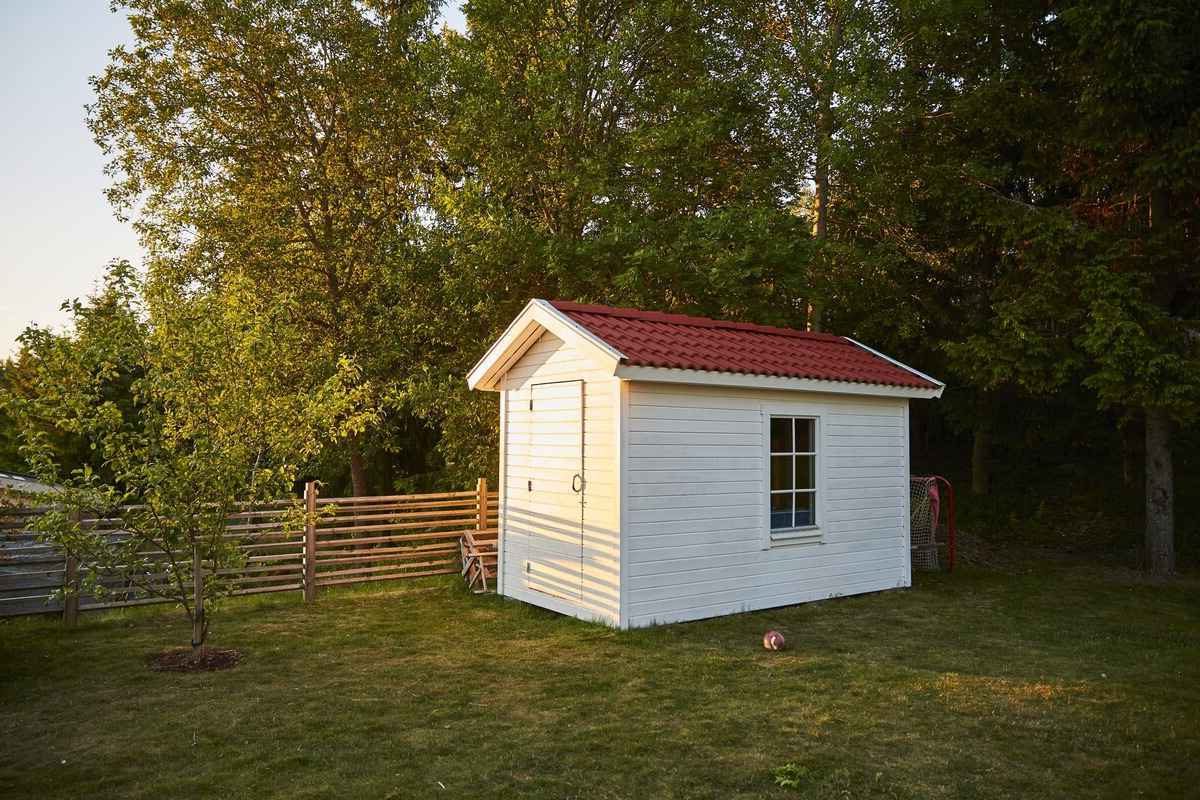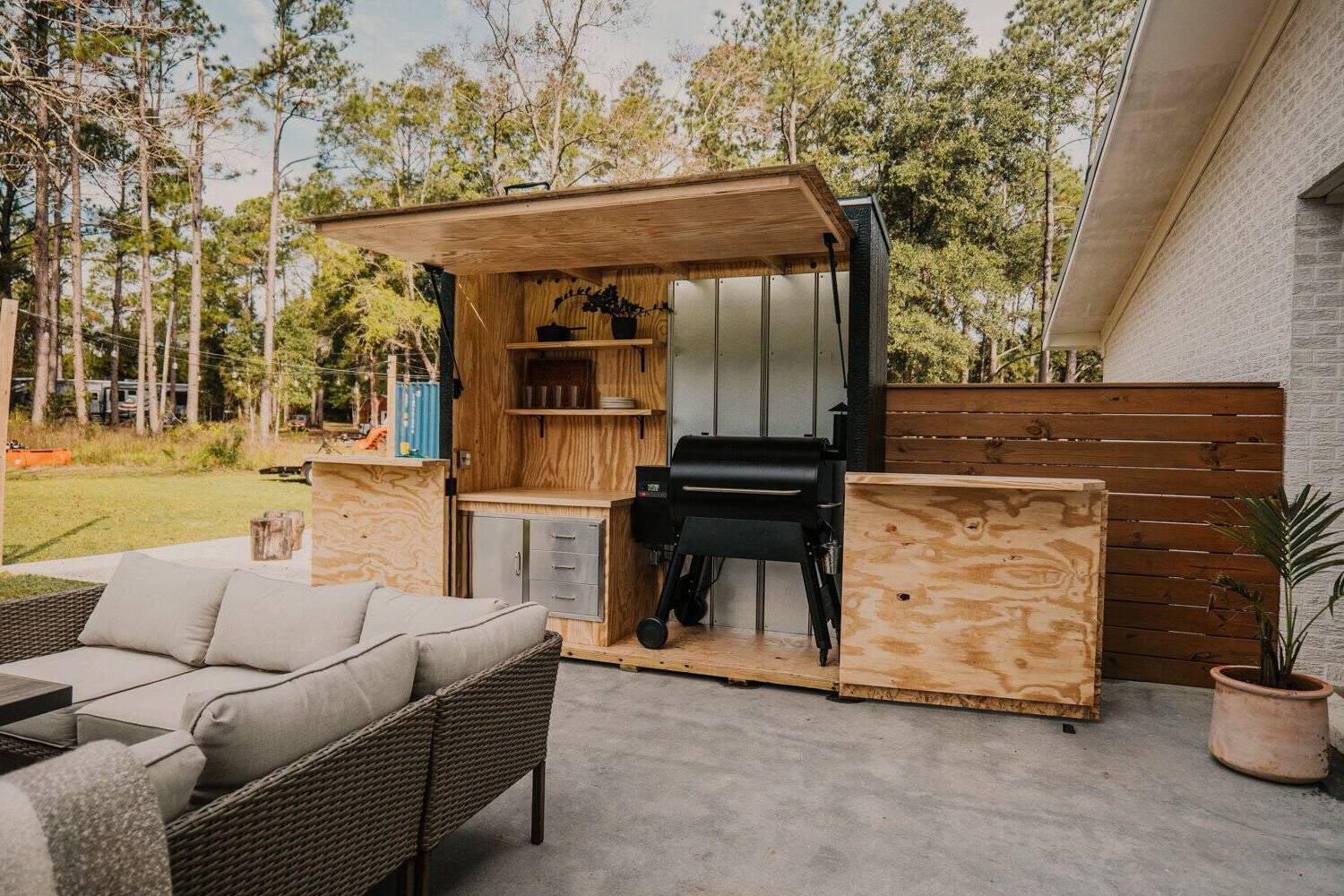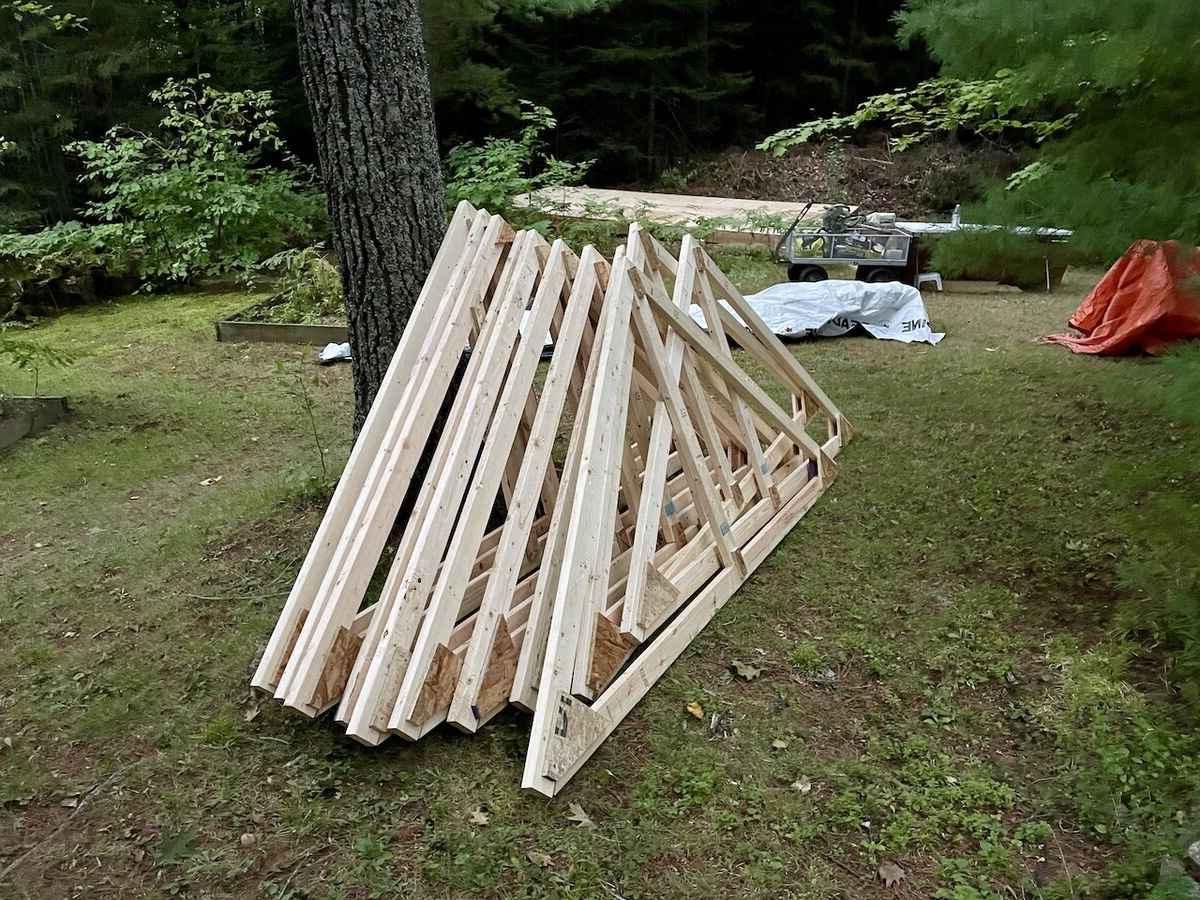Home>Create & Decorate>DIY & Crafts>12×24 Shed Plans: DIY Guide To Building Your Own Spacious Outdoor Storage


DIY & Crafts
12×24 Shed Plans: DIY Guide To Building Your Own Spacious Outdoor Storage
Published: February 27, 2024

Senior Editor in Create & Decorate, Kathryn combines traditional craftsmanship with contemporary trends. Her background in textile design and commitment to sustainable crafts inspire both content and community.
Discover step-by-step 12x24 shed plans for building your own spacious outdoor storage with this comprehensive DIY guide. Perfect for DIY & Crafts enthusiasts!
(Many of the links in this article redirect to a specific reviewed product. Your purchase of these products through affiliate links helps to generate commission for Twigandthistle.com, at no extra cost. Learn more)
Introduction
Are you in need of extra storage space for your outdoor equipment, tools, or seasonal items? Building a 12×24 shed might be the perfect solution for your storage needs. Whether you're a seasoned DIY enthusiast or a novice looking to embark on a new project, constructing your own spacious outdoor storage can be a rewarding and practical endeavor.
A 12×24 shed offers ample room to accommodate various items, from lawnmowers and gardening tools to bicycles and holiday decorations. With careful planning and the right materials, you can customize the shed to suit your specific storage requirements. Additionally, the process of building a shed provides an opportunity to hone your carpentry skills and unleash your creativity.
In this comprehensive guide, we will walk you through the step-by-step process of building a 12×24 shed. From selecting the ideal location and preparing the foundation to constructing the frame, installing the roof, and adding finishing touches, we will cover all the essential aspects of this DIY project. By the end of this guide, you will have the knowledge and confidence to embark on this fulfilling endeavor and create a functional and visually appealing outdoor storage space.
So, roll up your sleeves, gather your tools and materials, and get ready to embark on a rewarding journey of building your very own 12×24 shed. Whether you're seeking additional storage space, a workshop, or a cozy retreat, this guide will equip you with the necessary insights to bring your vision to life. Let's dive in and explore the exciting world of DIY shed construction!
Read more: DIY Garage Shed Plans Guide
Benefits of Building a 12×24 Shed
Building a 12×24 shed offers a multitude of benefits, making it a valuable addition to your property. Here are some compelling reasons to embark on this DIY project:
-
Ample Storage Space: A 12×24 shed provides generous storage capacity, allowing you to declutter your garage and free up space for vehicles or other activities. From lawnmowers and gardening tools to seasonal decorations and outdoor furniture, this spacious shed can accommodate a wide range of items, keeping them organized and easily accessible.
-
Versatility: Beyond storage, a 12×24 shed can serve various purposes, such as a workshop, hobby space, or even a cozy retreat. With ample room to customize the interior layout, you can create a functional and versatile space that aligns with your specific needs and interests.
-
Property Enhancement: Adding a well-built 12×24 shed can enhance the overall appeal and value of your property. It contributes to a more organized and aesthetically pleasing outdoor environment, which can be particularly advantageous if you plan to sell your home in the future.
-
Cost-Effective Solution: Opting to build a 12×24 shed as a DIY project can be a cost-effective alternative to purchasing a pre-built structure or renting off-site storage. By investing your time and effort, you can create a customized and durable storage solution at a fraction of the cost.
-
Personalization: Building your own shed allows for full customization, enabling you to tailor the design, features, and finishes to align with your preferences and complement your property's aesthetics. Whether you prefer a rustic barn-style shed or a modern and sleek design, the possibilities for personalization are virtually endless.
-
Skill Development: Engaging in the construction of a 12×24 shed presents an opportunity to enhance your carpentry skills and gain valuable hands-on experience. From framing and roofing to installing doors and windows, this project can expand your knowledge and proficiency in DIY construction.
-
Sustainable Living: Constructing a shed using eco-friendly materials and incorporating energy-efficient features, such as proper insulation and natural lighting, can contribute to sustainable living practices. This aligns with the growing emphasis on environmentally conscious home improvement projects.
By considering these benefits, you can gain a clear understanding of the value that a 12×24 shed can bring to your property and lifestyle. Whether you prioritize additional storage space, a versatile workshop, or a personalized retreat, this DIY endeavor offers a multitude of advantages that extend beyond mere functionality.
Tools and Materials Needed
Embarking on the construction of a 12×24 shed requires careful consideration of the essential tools and materials to ensure a smooth and efficient building process. By assembling the following items, you will be well-equipped to tackle each phase of the project with confidence and precision.
Tools:
- Measuring Tape: Essential for accurately determining dimensions and ensuring precise cuts and placements.
- Circular Saw: Ideal for cutting lumber and plywood with speed and accuracy.
- Power Drill: Necessary for driving screws and creating pilot holes for fasteners.
- Level: Crucial for maintaining the alignment and straightness of structural components.
- Hammer: Used for various tasks, including nailing framing members and securing hardware.
- Chalk Line: Aids in marking straight guidelines for layout and alignment purposes.
- Screwdriver Set: Includes both flathead and Phillips head screwdrivers for assembling components.
- Utility Knife: Useful for trimming materials and making precise cuts.
- Ladder: Provides safe access to elevated areas during construction and installation.
- Safety Gear: Includes goggles, gloves, and ear protection to ensure personal safety throughout the project.
Materials:
- Pressure-Treated Lumber: For framing, floor joists, and other load-bearing elements to withstand outdoor conditions.
- Plywood: Used for sheathing, subflooring, and roof decking to provide structural support.
- Roofing Materials: Such as shingles or metal panels to protect the shed from the elements.
- Fasteners: Including nails, screws, and anchors suitable for outdoor construction.
- Concrete Blocks or Piers: For creating a stable foundation to support the shed structure.
- Siding and Trim: Options include wood, vinyl, or metal siding for weatherproofing and aesthetic appeal.
- Doors and Windows: Pre-hung exterior doors and suitable windows for ventilation and natural light.
- Insulation: To regulate temperature and enhance energy efficiency within the shed.
- Moisture Barrier: Helps prevent water infiltration and protects the shed's interior from moisture damage.
- Paint or Stain: Provides a protective finish and enhances the shed's visual appeal.
By gathering these tools and materials, you will be well-prepared to commence the construction of your 12×24 shed. Additionally, ensuring the availability of quality equipment and durable building supplies will contribute to the longevity and functionality of the completed structure.
Choosing the Right Location
Selecting the optimal location for your 12×24 shed is a critical decision that significantly impacts its functionality, longevity, and overall visual appeal. Before breaking ground, carefully assess the following factors to ensure that the chosen site aligns with your practical needs and enhances the aesthetics of your property.
Accessibility and Convenience
Consider the accessibility of the shed in relation to its intended use. If the primary purpose is to store gardening tools and equipment, positioning the shed near the garden or yard can facilitate convenient access. For workshop-oriented sheds, proximity to the main residence may be preferable for easy access to utilities and supplies. Additionally, ensure that the location allows for smooth navigation when transporting items to and from the shed.
Sunlight and Ventilation
Optimal sunlight exposure and natural ventilation are essential for maintaining a healthy and functional shed interior. Position the shed in a manner that allows for sufficient sunlight throughout the day, especially if you plan to utilize the space for activities that benefit from natural light, such as crafting or woodworking. Adequate ventilation, achieved through strategic window placement and airflow considerations, contributes to a comfortable and well-ventilated interior environment.
Property Regulations and Boundaries
Before finalizing the shed's location, familiarize yourself with local building codes, zoning regulations, and property boundaries. Compliance with these regulations is crucial to avoid potential legal issues and ensure that the shed's placement adheres to established guidelines. Additionally, consider any easements, setbacks, or neighborhood covenants that may impact the permissible location of the shed on your property.
Read more: DIY Outdoor Kitchen Gazebo Build
Ground Stability and Drainage
Assess the stability of the ground where the shed will be situated. Ideally, select a level and well-drained area to prevent water accumulation and potential structural issues. If the ground is uneven, grading or leveling may be necessary to create a stable foundation for the shed. Furthermore, consider the natural drainage patterns of the site to prevent water pooling around the shed, which could lead to moisture-related problems over time.
Aesthetic Integration
The shed's location should harmonize with the overall aesthetic of your property. Take into account the visual impact of the shed within its surroundings, considering factors such as landscaping, sightlines from the main residence, and neighboring structures. By integrating the shed into the landscape with thoughtful placement and complementary design elements, you can enhance the overall visual appeal of your property.
By carefully evaluating these considerations, you can make an informed decision regarding the optimal location for your 12×24 shed. Thoughtful planning and attention to detail during this phase of the project lay the foundation for a successful and harmonious integration of the shed into your outdoor space.
Preparing the Foundation
The foundation serves as the anchor of any structure, providing stability and support. When preparing the foundation for a 12×24 shed, meticulous attention to detail is crucial to ensure the long-term durability and structural integrity of the building. Here's a comprehensive overview of the essential steps involved in preparing the foundation for your shed.
Clearing and Leveling the Site
Begin by clearing the designated area of any vegetation, debris, or obstructions. Use a shovel, rake, or brush cutter to remove grass, rocks, and roots, ensuring a clean and level surface for the foundation. It's imperative to achieve a uniform and level base to facilitate the subsequent construction phases and prevent potential issues with the shed's stability.
Marking the Foundation Layout
Using stakes and string, outline the perimeter of the shed's foundation according to the specified dimensions. This visual guide will help maintain accuracy during excavation and foundation construction. Double-check the layout's alignment and measurements to guarantee that the foundation will precisely accommodate the shed's footprint.
Excavating and Grading
Excavate the marked area to the required depth, typically accounting for the thickness of the foundation material and any recommended sub-base layers. A shovel, digging bar, or mini excavator can be utilized to remove soil and create a level excavation site. Pay close attention to achieving uniform depth and a smooth, compacted surface to support the foundation's load-bearing capacity.
Adding Sub-Base Material
For optimal stability and moisture control, consider adding a layer of compacted gravel or crushed stone to the excavated area. This sub-base material promotes proper drainage and prevents soil settlement, contributing to the longevity of the shed's foundation. Thoroughly compact the sub-base to create a solid and even surface for the subsequent foundation components.
Constructing the Foundation
Depending on your preference and local building codes, the foundation can be built using various methods, such as concrete footings, concrete slabs, or pressure-treated wood skids. Each approach offers distinct advantages in terms of cost, durability, and construction complexity. Ensure that the chosen foundation type aligns with your shed's design and the specific soil and climate conditions of your location.
By meticulously executing these foundation preparation steps, you establish a solid and reliable base for the 12×24 shed, setting the stage for the subsequent phases of construction. The foundation's quality and precision play a pivotal role in ensuring the overall stability and longevity of the completed structure, making it a fundamental aspect of the shed-building process.
Constructing the Frame
Constructing the frame of a 12×24 shed is a pivotal phase that lays the structural groundwork for the entire building. This process involves assembling the skeletal framework that supports the shed's walls, roof, and overall stability. Here's a detailed overview of the essential steps involved in constructing the frame of your shed.
1. Laying Out the Bottom Plates
Begin by laying out the pressure-treated bottom plates according to the shed's floor plan. These plates serve as the base for the wall framing and are secured to the foundation using anchor bolts or concrete screws. Ensure that the bottom plates are precisely aligned and squared to establish a solid foundation for the wall framing.
2. Assembling the Wall Framing
Using the specified lumber dimensions, cut the wall studs to the appropriate lengths and assemble them into wall frames. Incorporate door and window openings as per the shed's design, ensuring accurate measurements and proper framing techniques. Once the wall frames are assembled, raise them into position and secure them to the bottom plates, ensuring plumb and alignment.
3. Installing the Ridge Beam and Rafters
With the walls in place, focus on installing the ridge beam and rafters to form the shed's roof structure. The ridge beam provides central support for the roof, while the rafters create the framework for the roof's slope. Carefully position and secure the ridge beam, followed by the installation of the rafters at the specified intervals, ensuring consistent spacing and alignment.
Read more: DIY Clothing Organization Ideas
4. Adding Bracing and Structural Support
Incorporate diagonal bracing within the wall frames and roof structure to enhance the shed's overall stability and resistance to lateral forces. Diagonal bracing effectively distributes loads and reinforces the frame against potential structural movement. Additionally, consider installing collar ties or ceiling joists to further strengthen the roof structure and prevent sagging over time.
5. Securing the Frame Components
Throughout the frame construction process, prioritize the use of quality fasteners, such as galvanized nails or structural screws, to secure the frame components. Proper fastening techniques and hardware selection are crucial for ensuring the long-term integrity and durability of the shed's frame, especially in the face of external elements and environmental factors.
By meticulously executing these frame construction steps, you establish a robust and reliable framework for the 12×24 shed, setting the stage for the subsequent phases of the building process. The frame's precision and structural integrity play a pivotal role in ensuring the overall stability and longevity of the completed structure, making it a fundamental aspect of the shed-building endeavor.
Installing the Roof
The installation of the roof is a critical phase in the construction of a 12×24 shed, as it not only provides protection from the elements but also contributes to the overall structural integrity and aesthetic appeal of the building. Here's a detailed overview of the essential steps involved in installing the roof of your shed.
1. Roof Sheathing
Begin by applying the roof sheathing, typically in the form of plywood or oriented strand board (OSB), to the rafters. Ensure that the sheathing panels are aligned and securely fastened to the rafters using appropriate nails or screws. Properly installed roof sheathing forms a solid base for the subsequent roofing materials and enhances the overall stability of the roof structure.
2. Underlayment Installation
Once the sheathing is in place, it's crucial to install a weather-resistant underlayment to provide an additional layer of protection against moisture infiltration. Common underlayment materials include roofing felt or synthetic membranes. Carefully roll out and secure the underlayment across the entire roof surface, overlapping the seams to create a watertight barrier.
3. Roofing Material Application
Select the roofing material that best suits your shed's design and climate considerations. Options range from traditional asphalt shingles to metal panels, wood shakes, or composite roofing materials. Follow the manufacturer's guidelines and best practices for the installation of the chosen roofing material, ensuring proper alignment, fastening, and weatherproofing techniques.
4. Flashing and Edge Detailing
Incorporate flashing components, such as drip edge and valley flashing, to safeguard vulnerable areas of the roof against water intrusion. Properly installed flashing enhances the shed's resilience to water damage and prolongs the lifespan of the roofing system. Additionally, pay attention to edge detailing and trim work to create a polished and professional finish along the roof's perimeter.
5. Ventilation Considerations
Integrate roof ventilation elements, such as ridge vents or soffit vents, to promote air circulation and prevent moisture buildup within the shed's attic or interior space. Adequate ventilation contributes to temperature regulation and moisture control, enhancing the overall longevity and functionality of the shed's roofing system.
By meticulously executing these roof installation steps, you ensure the creation of a durable, weather-resistant, and visually appealing roof for your 12×24 shed. The roof's quality and precision play a pivotal role in safeguarding the shed's interior and contents, making it a fundamental aspect of the shed-building process.
Read more: DIY Bath Crashers: Transform Your Bathroom
Adding Siding and Trim
The addition of siding and trim marks a significant phase in the construction of a 12×24 shed, as it not only contributes to the aesthetic appeal of the structure but also serves as a protective barrier against the elements. Here's a detailed overview of the essential steps involved in adding siding and trim to your shed.
1. Siding Installation
Select the appropriate siding material based on your preferences, budget, and climate considerations. Common options include wood, vinyl, metal, or composite siding. Begin by carefully measuring and cutting the siding panels to fit the shed's walls, ensuring precise alignment and a professional finish. Secure the siding panels to the wall framing using recommended fasteners, following the manufacturer's guidelines for spacing and installation techniques. Pay close attention to corner details and window/door openings, incorporating trim elements as needed to create a seamless and visually appealing exterior.
2. Trim Detailing
Incorporate trim elements, such as corner boards, fascia, and window/door casings, to enhance the visual appeal and weatherproofing of the shed's exterior. Trim detailing adds a decorative touch while concealing seams and providing additional protection against moisture infiltration. Carefully measure, cut, and install the trim components, ensuring tight joints and smooth transitions between different sections of the shed's exterior. Properly executed trim detailing elevates the overall aesthetics of the shed while contributing to its long-term durability.
3. Weatherproofing Measures
As you install the siding and trim, pay attention to weatherproofing details to safeguard the shed against moisture and environmental exposure. Sealant or caulking may be used to fill gaps and joints, preventing water penetration and enhancing the shed's resilience to the elements. Additionally, consider incorporating flashing details around windows, doors, and intersecting rooflines to redirect water away from vulnerable areas and maintain a watertight exterior envelope.
Read more: DIY Outdoor Concrete Countertops
4. Finishing Touches
Once the siding and trim are in place, take the time to inspect the exterior for any imperfections or areas that require additional attention. Sand rough edges, touch up paint or stain where necessary, and ensure that all siding and trim components are securely fastened and properly aligned. Attention to detail during the finishing touches phase contributes to a polished and professional appearance, elevating the overall visual impact of the shed's exterior.
By meticulously executing these siding and trim installation steps, you enhance the shed's visual appeal and fortify its exterior against the elements, ensuring a durable and aesthetically pleasing finish. The quality and precision of the siding and trim installation play a pivotal role in protecting the shed's structure and contents, making it a fundamental aspect of the shed-building process.
Building the Doors and Windows
The installation of doors and windows in a 12×24 shed is a crucial step that enhances functionality, aesthetics, and overall usability. Properly constructed and strategically placed doors and windows not only facilitate access and natural light but also contribute to ventilation and visual appeal. Here's a detailed overview of the essential steps involved in building and installing doors and windows for your shed.
1. Door Construction
Begin by selecting the type of door that best suits your shed's design and functional requirements. Common options include single or double hinged doors, sliding doors, or roll-up doors, each offering distinct advantages in terms of accessibility and space utilization. Once the door type is determined, proceed with the construction of the door frame, ensuring precise measurements and sturdy assembly. Incorporate bracing and reinforcement to fortify the door frame against potential warping or structural compromise over time. Additionally, consider the inclusion of weather-stripping and threshold components to enhance the door's weatherproofing and energy efficiency.
2. Window Assembly
When selecting windows for your shed, consider factors such as size, style, and placement to optimize natural light and airflow. Whether opting for fixed, sliding, or awning windows, prioritize energy-efficient designs and durable construction to withstand outdoor exposure. Assemble the window frames with attention to squareness and structural integrity, ensuring a snug fit within the wall openings. Incorporate weather-resistant seals and proper flashing details to prevent water infiltration and maintain a watertight seal around the windows.
Read more: DIY Outdoor Bathroom Renovation Guide
3. Installation Process
Carefully position the pre-assembled doors and windows within the designated openings, ensuring proper alignment and secure anchoring to the shed's framing. Utilize quality hardware and fasteners to affix the doors and windows, prioritizing smooth operation and a tight seal to prevent air and water leakage. Pay attention to the integration of trim elements around the door and window openings, creating a polished and weather-resistant transition between the frames and the surrounding siding.
4. Weatherproofing and Finishing
Apply exterior-grade caulking or sealant around the perimeter of the installed doors and windows to seal any gaps and prevent moisture intrusion. Additionally, consider the application of a protective finish, such as paint or stain, to the door and window frames to enhance their durability and resistance to outdoor elements. Properly executed weatherproofing and finishing measures contribute to the long-term performance and visual appeal of the doors and windows, ensuring their seamless integration into the shed's exterior.
By meticulously executing these steps, you ensure the successful construction and installation of doors and windows, enhancing the functionality, aesthetics, and weather resistance of your 12×24 shed. The quality and precision of the doors and windows play a pivotal role in creating a welcoming and well-ventilated interior space, making it a fundamental aspect of the shed-building process.
Finishing Touches
As the construction of the 12×24 shed nears completion, attention to the finishing touches elevates the overall aesthetics, functionality, and longevity of the structure. This phase encompasses a range of essential tasks and enhancements that contribute to the polished and professional appearance of the shed, ensuring that every detail is meticulously addressed.
1. Exterior Detailing
The exterior of the shed benefits from meticulous attention to detail during the finishing touches phase. This includes the application of a protective finish, such as paint or stain, to the siding, trim, doors, and windows. The chosen finish not only enhances the visual appeal of the shed but also provides crucial protection against weathering, UV exposure, and moisture infiltration. Careful consideration of color schemes and exterior accents further adds to the shed's overall curb appeal, harmonizing with the surrounding landscape and property aesthetics.
Read more: DIY Closet Remodel Guide
2. Interior Customization
With the structural components in place, the interior of the shed becomes a blank canvas for customization. Consider incorporating organizational features such as shelving, pegboards, and storage systems to optimize the functionality of the space. Additionally, the application of interior finishes, such as paint or sealant, contributes to a clean and inviting interior environment. Thoughtful lighting solutions, such as LED fixtures or natural light sources, further enhance the usability and ambiance of the shed's interior.
3. Hardware and Accessories
The selection and installation of quality hardware and accessories add the final touches to the shed's functionality and visual appeal. This includes the integration of door handles, locks, hinges, and window latches that not only provide security but also complement the shed's design. Additionally, consider the addition of exterior lighting, decorative accents, and signage to personalize the shed and create a welcoming entryway.
4. Landscaping Integration
The surrounding landscape plays a significant role in the overall presentation of the shed. Thoughtful landscaping integration, such as the addition of pathways, flower beds, or potted plants around the shed, enhances its visual impact and creates a cohesive outdoor environment. Consideration of drainage solutions and the strategic placement of the shed within the landscape further contributes to its seamless integration into the property.
5. Final Inspection and Maintenance
Before considering the shed project complete, conduct a thorough inspection of the entire structure, addressing any remaining imperfections or areas requiring touch-ups. Ensure that all fasteners are tightened, seals are intact, and surfaces are free from defects. Additionally, provide guidance on ongoing maintenance practices, such as periodic inspections, cleaning routines, and seasonal upkeep, to preserve the shed's condition and longevity.
By meticulously attending to these finishing touches, the 12×24 shed is transformed into a functional, visually appealing, and enduring addition to the property. The culmination of these details reflects the dedication to craftsmanship and ensures that the shed stands as a testament to quality construction and thoughtful design.
Read more: How to Build a Traeger Outdoor Kitchen
Conclusion
In conclusion, the journey of building a 12×24 shed is a testament to the power of DIY construction and the fulfillment that comes with creating a functional and personalized outdoor space. From the initial planning stages to the meticulous execution of each construction phase, this endeavor represents a harmonious blend of practicality, creativity, and craftsmanship. As the final touches are applied and the shed stands as a completed structure, it serves as a tangible representation of dedication, skill development, and the realization of a vision.
The benefits of constructing a 12×24 shed extend far beyond the additional storage space it provides. It embodies versatility, offering the potential to serve as a workshop, hobby space, or retreat, tailored to the unique needs and interests of the builder. The cost-effective nature of this DIY project, coupled with the opportunity for skill development and customization, underscores the value it brings to both the property and the individual's craftsmanship journey.
The process of building a 12×24 shed is not merely a construction project; it is a transformative experience that fosters a deeper connection to the property and the surrounding landscape. The careful selection of the shed's location, the meticulous preparation of the foundation, and the thoughtful integration of doors, windows, and finishing touches reflect a holistic approach to outdoor space enhancement.
As the shed becomes an integral part of the property, it stands as a testament to sustainable living practices, showcasing the potential for eco-friendly construction and energy-efficient design. The integration of landscaping elements further enhances its seamless integration into the outdoor environment, creating a cohesive and visually appealing property.
Ultimately, the completion of a 12×24 shed represents the culmination of dedication, craftsmanship, and the pursuit of a practical and rewarding DIY project. It stands as a testament to the transformative power of hands-on construction, the value of personalized outdoor spaces, and the enduring satisfaction of bringing a vision to life through skillful execution. Whether utilized for storage, creative pursuits, or relaxation, the 12×24 shed stands as a symbol of accomplishment and the potential for endless possibilities within the realm of DIY construction.





